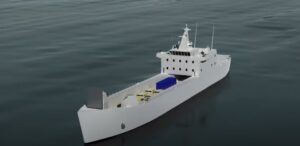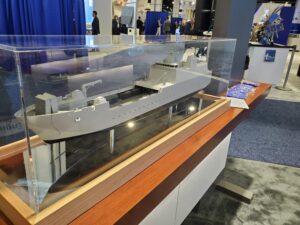Several Navy officials recently confirmed the Navy and Marine Corps compromised on designs for the new Landing Ship Medium (LSM) and laid out the upcoming schedule, but also said it will be a warship that goes into contested environments.
The Navy and Marine Corps earlier disagreed on the requirements for the LSM, previously called the Light Amphibious Warship (LAW), with the Navy preferring fewer ships that were larger and more expensive while the Marine Corps sought a larger number of lighter vessels.

“That has been resolved…but in general, it’s like a marriage, compromise is important. And I will say that in the end everybody lined up on the requirements,” Tom Rivers, executive director at program executive office, ships, said during the National Defense Industrial Association’s (NDIA) annual Expeditionary Warfare Conference on Feb. 23.
Angela Bonner, deputy program manager of the Amphibious Assault and Connectors program office, PMS-317, said that over the last year the two services agreed on the requirements for LSM and the Navy completed preliminary design.
“We’re moving forward to release our request for proposal into this fall and we have an FY ‘25 detail design and construction award for that,” Bonner continued.
Rivers said the studies that Bonner’s team has been working on over the last few years will be very similar to what the requirements are, plus relatively minor tweaks.
“For the most part, that track hasn’t changed dramatically,” Rivers said.
Bonner agreed with the marriage compromise analogy, arguing that “we all won…but it was a compromise and we came up with requirements.”
She confirmed there are no specific protection weapons selected yet, like a 30mm gun, except knowing there will be some 30mm gun weapon on the ship.
“We haven’t picked a specific design, we haven’t done detailed design, we’ve got five different companies that did preliminary design. So we haven’t downselected the design yet.”
Also speaking at the event, Brig. Gen Marcus Annibale, USMC director, expeditionary warfare (OPNAV N95), said the five companies that previously won government funding for preliminary design include Bollinger Shipyards, VT Halter Marine, Fincantieri Marinette Marine, Austal USA, and TAI Engineers.
Annibale noted that in November, Bollinger completed an acquisition of VT Halter for $15 million, saying that seems to give Bollinger two designs for the price of one (Defense Daily, Nov. 14).
He underscored that this “doesn’t mean somebody else cannot bid once the [Capability Development Document] is published – they can compete, but those are the five government-funded down-selected designs.”
Bonner said the request for proposals for the construction contract should go out this upcoming fall, and the contract should be awarded by early fiscal year 2025 or fall of 2024.

Judd Krier, OPNAV N953 amphibious warfare branch head, said the first LSMs should be delivered around 2028 to 2029.
Bonner confirmed one of the five companies competing is using a stern ramp design while the other four are using bow ramps. She said the final LSM will only use one or the other and not both types of ramp.
Krier also underscored the LSM is part of tactical maneuver forces and “it will and it is going to go into contested environments. This is not a single mission ship, this ship will do multiple missions. This will be a naval warship that will do multiple things, including theater security, humanitarian assistance and disaster relief and will work closely with allies and partners throughout the region.”
He said the LSM will offer full protection for the crew and its embarked forces, but emphasized it does not replace the amphibious transport docks (LPD), dock landing ships (LSDs), or connectors like the incoming LCAC-100-class Ship-to-Shore Connectors because it goes from shore to shore, without needing any port services to sustain them.
Separately, Bonner said she believed the ship type name was changed from Light Amphibious Warship to landing Ship Medium “to avoid some of the confusion” between talking about traditional larger L-class amphibious ships and the smaller LSM.